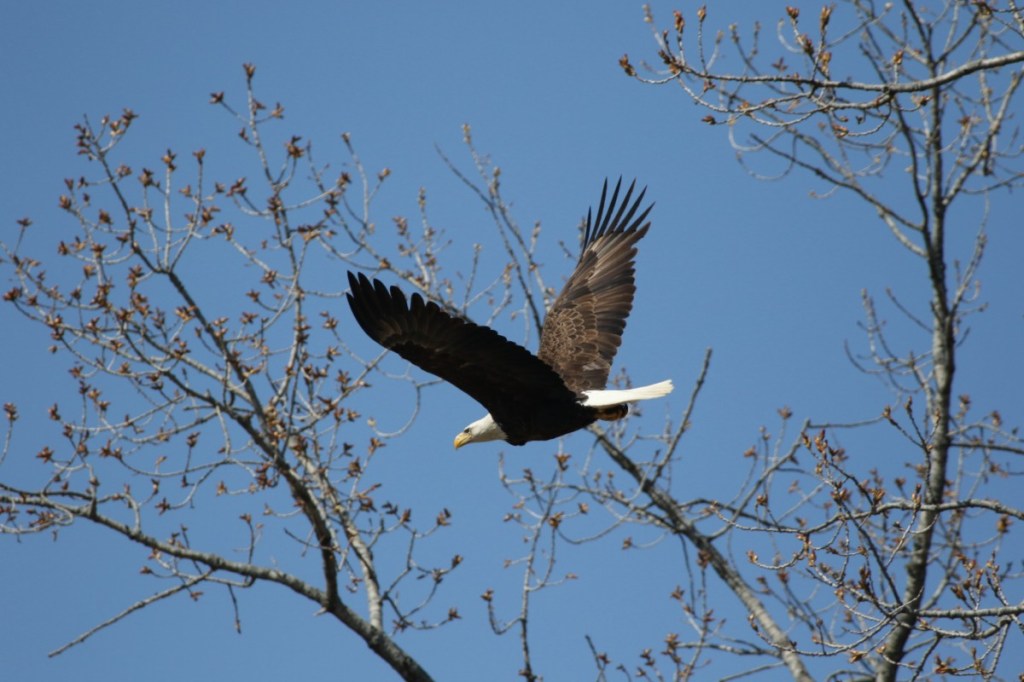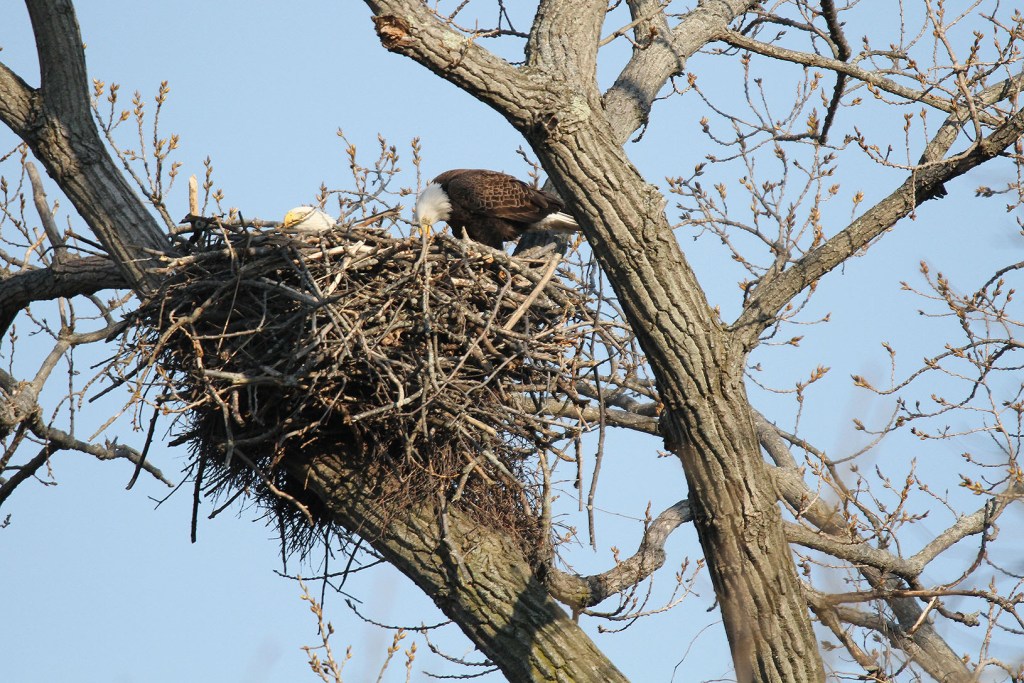Triplets again—for the third year in a row! I’m not talking about prolific humans, but the Bald Eagle (Haliaeeatus leucocephalus) pair nesting in a giant Cottonwood (Populus deltoides) tree along the Quinnipiac River marsh in Hamden, Connecticut. This nest site is in the Hamden Land Conservation Trust’s Henry and Irene Gargiulo Wildlife Refuge. The three chicks are now flapping and testing their wings in the nest. Any day now, they will fly out to a nearby branch and be taking off by the end of June.

Bald Eagles usually lay two eggs. Successfully raising three chicks is relatively rare for eagles. It is a sign of experienced parents, as well as the clean water with plenty of fish in the Quinnipiac River ecosystem. The expansion of the Clean Water Act in 1972 really made a difference in U.S. waterways.
Eagle nests were not always successful. From the 1950s to the 1980s there were no nesting Bald Eagles in Connecticut. The persistent pesticide DDT had traveled up through the food web and caused endocrine problems in eagles. Eggs had thin shells and eagles were unsuccessful in rearing chicks. The Yale Peabody Museum was among the institutions that documented eggshell thinning through specimens in its collections.
The Bald Eagle was one of the first species put on the U.S. Fish and Wildlife Service’s endangered species list in 1967. DDT was banned in the United States in 1972. Bald Eagles and other raptors slowly began to recover. This recovery has been a real success story. In 2007 the Bald Eagle was removed from the list.
During the 2019 breeding season there were over 316,000 Bald Eagles in the lower 48 states, including more than 71,000 breeding pairs. In 2020, Connecticut Department of Energy and Environmental Protection (DEEP) staff and volunteers recorded 47 successful Bald Eagle nests that hatched 88 chicks, smashing earlier records.
According to Connecticut DEEP Eagle Nest Watch volunteer Mike Horn, the female eagle at the Henry and Irene Gargiulo Wildlife Refuge nest in Hamden laid three eggs. A chick hatched every few days at end of February. Eagles have evolved to lay eggs not all at once, but sequentially, as insurance. If something happens to the first chick there is another to take its place. Although obligate siblicide, in which a larger chick kills its sibling, occurs in some eagle species, it is rare among Bald Eagles. According to Connecticut DEEP biologist Brian Hess, chick mortality is caused by sibling competition when there is a lack of resources and usually not by direct attacks from a larger chick.
The three eggs hatched during the week of April 5, 2021. After a few weeks, it was thought that there were two chicks because the parents were bending over and feeding in different areas of the nest. After about five weeks, the smaller third chick was seen poking its head over the nest rim.
At first the parents will bring fish and break it into smaller pieces to gingerly feed their chicks. As they grow, food is left whole and the young will do the work.

Bald Eagle nests can grow to be huge structures weighing up to a ton (907 kilograms). An eagle pair will add sticks to the nest every nesting season. They don’t remove leftover food and just add sticks and leaves on top. Sometimes pairs will build a new fresh nest nearby.

With so many wildlife species in decline of late, a boom in Bald Eagle populations is a real conservation success story. But it is one where we need to be vigilant in maintaining clean waterways and restricting harmful pesticides. That way, wild Bald Eagles will continue to thrive.
Thanks for this article. You made my day! bj
________________________________
LikeLike
Thx Barbara, Best, Jim
LikeLike
Very nice article, Jim. Aren’t you glad you’re not a Jackrabbit any more?
LikeLike
Yes, Beth ….my nature name Jim Jackrabbit from the old nature center days! Luckily there aren’t any jackrabbits in CT. They’re a favorite food of golden eagles though. Cheers, Jim
LikeLike
I really enjoyed this wonderful article and photos of the eagle family! It must be very exciting to observe the eagle pair as they establish their nest and lay eggs in winter to fledging their chicks by summer. I am curious about what happens to the chicks after they leave the nest. Do DEEP volunteers continue to moniter the fledglings?
LikeLike
Hi Linda, It’s pretty hard to monitor fledglings once they disperse, but they often hang around the nest for a while too and are seen and monitored then. There was one year when young birds from the year before returned and hung out. Sometimes the parents don’t tolerate them very well though! All best,
Jim
LikeLike